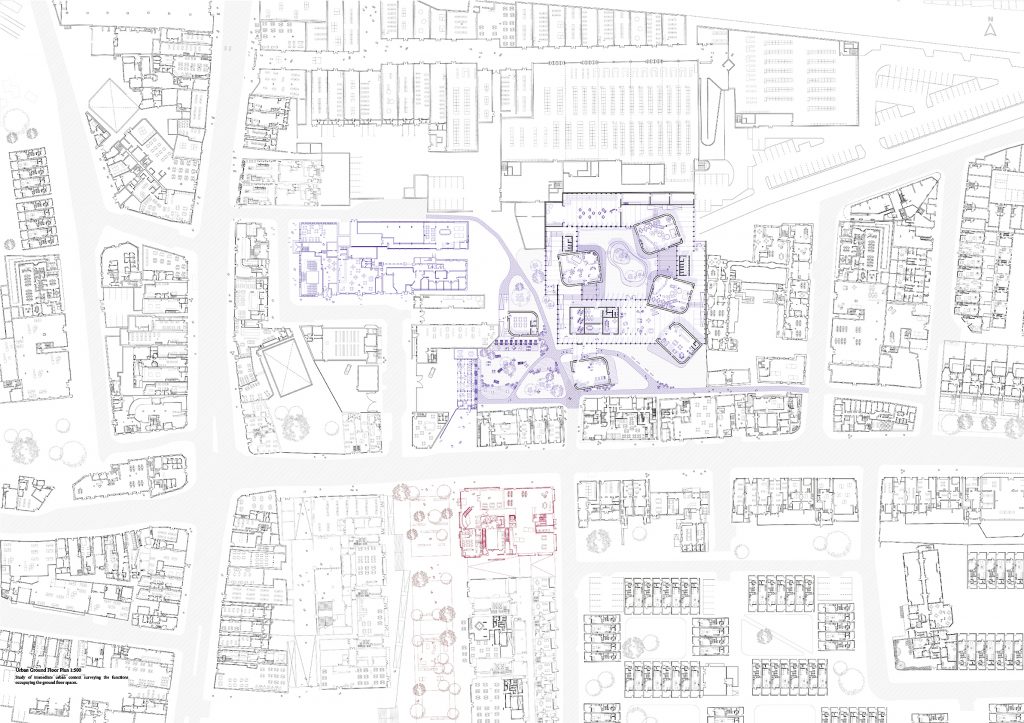
Kimberley Burton-Lynch is a South East London based part two architectural assistant due to start her part 3 in January 2020. With a background focussed on the discussion of civic spaces in urban situations, at the root of her work is the question of how people take ownership of space and how a sense of place manifests in the community; and the role the architect has in effecting this.
Her thesis project The Civic Junction investigated key civic clusters in Dalston Junction, Hackney. Analysing them in terms of proximity and intersections, saturated space as well as boarder and boundary conditions. Her research and case study analysis concluded with establishing that the principles found to be integral to civic spaces were a combination of density and diversity of programme; stimulating intensity of social interactions and exchange; encouraging richness of place, identity and social inclusion; enabling civic spaces to become an anchor within their urban context and local community. This formed the foundation of her final year design project.
University of Nottingham Department of Architecture and Built Environment 2019, Urban Design Award 1stPrize
Nottingham and Derby Society of Architects 2019, Most Responsive Design to the Urban Realm and Placemaking Award
+++
Q&A with Kimberley Burton-Lynch, June 2020
How did you get started?
Thinking back, my route to architecture started with a shoebox. My mum always encouraged me to make things out of whatever we had spare in the house and an early memory was presenting my mum with a shoebox that I had transformed into a restaurant for my toys, using things like yoghurt pots, ripping up old clothes and assembling with hairbands and a lot of PVA! I’m not sure it was inevitable, there have been many obstacles to overcome, but I think I was always going to end up doing something that involved creating spaces in some form.
What type of work do you make?
I mainly work with CAD and computer rendering, but I enjoy making models by hand too. An element of architecture that influences how I approach projects is how we create and influence public space and the activities and autonomy people have when using them. Growing up in London has definitely influenced my interest in understanding density, diversity of space and activity and why it is important in encouraging ownership of space and community.
Describe a typical day in the studio?
I work in a medium sized practice and its usually a space in which we can openly discuss each other’s projects, draw from others knowledge and strengths. Which is great because as I’m studying for my Part 3 I feel like I get a lot of support to learn more about stages of projects I have little experience in. Covid-19 and working from home was an adjustment at first because it was easy to not keep a mindful working routine, as the work life threshold was more blurred. But I feel like as a practice we’ve adapted how we collaborate and keep in contact with each other with video conferencing and social media. We also continue to enjoy Friday drinks every week just over zoom!
What are you currently working on?
One project that I’m enjoying at work is a set of design guidelines for grade II listed college building. I always find that strong visuals supported by development are great for breaking down designs to clients, but I’ve found that not being able to present in person means that this has become more important for clients to engage with our work.
What are some of the key influences for your work?
One architect that comes to mind is Francis Kere. I’ll always be inspired by how he puts people at the heart of his architecture, there’s a sense of social activism behind his work that I admire. I also love his use of texture and ornateness when he approaches materiality. Also at the moment the work being done by Yinka Ilori with colour, pattern and story.
What kind of cultural engagement are you turning to while we are temporarily unable to get to museums, galleries, theatres and events?
I like to browse the AJ, Dezeen and ArchDaily. And there have been some interesting interviews being done as part of Virtual Design Festival.
What is the most surprising thing to you about the Chelsea Arts Club?
I didn’t really know what to expect from a members club, but kept an open mind. The no phones rule was a surprise but its created such a unique environment where people feel more open to actually talking to one another!
The thought that gets me out of bed each day is…
That first cup of tea!
Image: The Civic Junction Design Project
